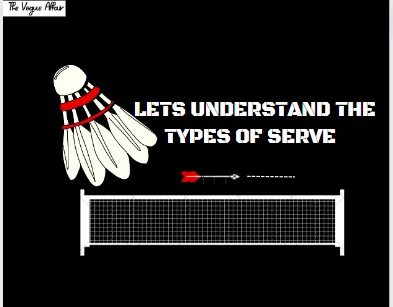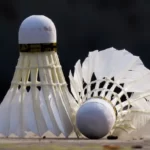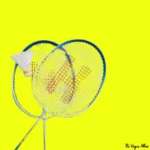
The serve is the first shot in a badminton rally, and it sets the tone for the rest of the point. A good serve can put your opponent on the defensive and give you an immediate advantage, while a poor serve can put you in a difficult position right from the start. That’s why it’s important to master different types of serves to keep your opponent guessing and maintain control of the rally.
There are basically 4 types of serves in badminton, each with its own unique advantages. Let’s understand them one by one:
1) High Serve
A high serve, also known as a long serve, is a powerful shot that is hit with a lot of upward motion and aimed at the furthest corner away from the server in the receiver’s backcourt. The serve’s trajectory should be similar to that of a deep lift shot, with the shuttle obtaining its peak at the back of the receiver’s court before descending sharply near the back service boundary.
One of the most important aspects of a high serve is that it should be executed using only the forehand grip. This is due to the fact that a high serve demands a substantial amount of energy transfer, which is most efficiently accomplished in a full swing.
Power is delivered to the serve when a player transfers the weight from the rear foot to the front foot while delivering the serve. It is uncommon for players to have the wrist power to throw a backhand high service that is as high and as far as a forehand high serve.
When should you use a high serve?
You should use this service when your opponent is not expecting the same. A high serve that targets the furthest corner from the server puts the opponent in their backcourt near the edge. This serve is a great way to put pressure on the opponent, especially if they are not comfortable playing high shots or are weak at the net. Additionally, it can be an effective way to set up a smash as the high trajectory of the serve makes it more difficult for the opponent to return the shot.
2) Low Serve
The low serve is a shot that is hit in such a way that it goes just over the net and lands close to the net at the opponent’s side. It is designed to limit the options of the opponent and force them to play a low shot. A well-executed low serve will immediately drop after crossing the net, landing close to the net, making it difficult for the opponent to return the shot.
When Should You Use a Low Serve?
A low serve is often used in doubles play because the smaller service area in doubles makes it harder to take full advantage of a high serve. By targeting the short service line, restricts the opponent’s range of motion and shot choices on the return of serve. It can also be an effective strategy against tall or aggressive players, who may struggle with shots hit at a lower level. A low serve can also be used to set up net shots, as it forces the opponent to play a low shot. Overall, a low serve is a great way to keep your opponents on the defensive and control the pace of the game.
3) Flick Serve
A flick serve, also known as a chop serve, is a shot that is hit with a quick wrist motion, causing it to spin and change direction. This service is designed to surprise the opponent and make it difficult for them to understand the spin. The flick serve is usually hit with a backhand grip and is aimed at the receiver’s backhand side.
The key to executing a successful flick serve is to generate a lot of spin on the shuttlecock. This is achieved by whipping the racket through the shuttlecock quickly and with a lot of wrist action. The spin on the shuttlecock causes it to change direction, making it difficult for the opponent to predict where the shuttlecock will go.
When should you use a flick serve?
The flick serve is most effective when used in doubles play, where the receiver is typically positioned near the short service line, expecting a short serve. Incorporating a flick serve into your serving technique, it can deter over-aggressive receivers and add a necessary element of surprise to your game. In singles play, a flick serve can also be effective as it is not commonly practiced and can catch your opponent off guard. When playing against a forward-positioned receiver, a strong flick serve executed with a wrist can be a great option to catch them off guard.
4) Drive Serve
A drive serve is a shot that is hit with a lot of forward motion, making it difficult for your opponent to return. The drive serve is usually hit with a forehand grip and is aimed at the receiver’s body. The key to executing a successful drive serve is to generate a lot of speed and power on the shuttlecock. This is achieved by swinging the racket through the shuttlecock with a lot of force and a full arm motion. The speed and power on the shuttlecock cause it to travel quickly and with a lot of force, making it difficult for the opponent to return.
When should you use a drive serve?
The drive serve is a powerful shot that can be used in both singles and doubles play, but is particularly effective in doubles play due to the positioning of the receiver and the shorter service boundary at the far end of the court.
Similar to the flick serve, the drive serve can be a dangerous weapon due to its element of surprise. It can be used to break the rhythm of the game and keep opponents on their toes.
If your opponents have grown accustomed to your low serve or even a flick serve, try incorporating a drive serve to mix things up. Additionally, the drive serve is particularly effective against players with slower reaction times, such as tall opponents, as the speed and flat trajectory of the shot can test their racket-handling skills and catch them off guard.
Hope, now you are clearly understood the 4 types of serves in badminton and their importance in your badminton career.



1 thought on “The Different Types of Serves in Badminton That You Need to Know”